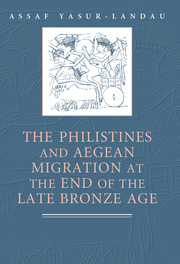Book contents
- Frontmatter
- Contents
- Acknowledgments
- INTRODUCTION
- 1 THE ARCHAEOLOGICAL IDENTIFICATION OF MIGRATION AND OTHER RANGES OF INTERREGIONAL INTERACTIONS
- 2 SETTING THE SCENE: THE MYCENAEAN PALATIAL CULTURE AND THE OUTSIDE WORLD
- 3 THE TWELFTH-CENTURY-BCE AEGEAN: POLITICAL AND SOCIAL BACKGROUND
- 4 PRECONDITIONS FOR MIGRATION
- 5 ALONG THE ROUTES
- 6 STRICTLY BUSINESS? THE SOUTHERN LEVANT AND THE AEGEAN IN THE THIRTEENTH TO THE EARLY TWELFTH CENTURY BCE
- 7 THE MATERIAL CULTURE CHANGE IN TWELFTH-CENTURY PHILISTIA
- 8 THE PHILISTINE SOCIETY AND THE SETTLEMENT PROCESS
- 9 A SHORT HISTORY OF THE AEGEAN IMMIGRATION TO THE LEVANT
- Bibliography
- Index
3 - THE TWELFTH-CENTURY-BCE AEGEAN: POLITICAL AND SOCIAL BACKGROUND
Published online by Cambridge University Press: 04 August 2010
- Frontmatter
- Contents
- Acknowledgments
- INTRODUCTION
- 1 THE ARCHAEOLOGICAL IDENTIFICATION OF MIGRATION AND OTHER RANGES OF INTERREGIONAL INTERACTIONS
- 2 SETTING THE SCENE: THE MYCENAEAN PALATIAL CULTURE AND THE OUTSIDE WORLD
- 3 THE TWELFTH-CENTURY-BCE AEGEAN: POLITICAL AND SOCIAL BACKGROUND
- 4 PRECONDITIONS FOR MIGRATION
- 5 ALONG THE ROUTES
- 6 STRICTLY BUSINESS? THE SOUTHERN LEVANT AND THE AEGEAN IN THE THIRTEENTH TO THE EARLY TWELFTH CENTURY BCE
- 7 THE MATERIAL CULTURE CHANGE IN TWELFTH-CENTURY PHILISTIA
- 8 THE PHILISTINE SOCIETY AND THE SETTLEMENT PROCESS
- 9 A SHORT HISTORY OF THE AEGEAN IMMIGRATION TO THE LEVANT
- Bibliography
- Index
Summary
Now Mycenae may have been a small place, and many of the cities of that age may appear comparatively insignificant, but no exact observer would therefore feel justified in rejecting the estimate given by the poets and by tradition of the magnitude of the armament.
– Thucydides 1.10.1 (Strassler 1996)CHANGING RULERSHIP AND THE DECAPITATION THEORY
The world that created the Philistine migration was not the thirteenth-century-bce world of Mycenaean palaces with its impressive administrative abilities but rather a new Aegean social order created in the twelfth century, the LHIIIC period (Fig. 3.1), after the demise of the palatial system. With the destruction of all the Mycenaean palaces at the turn of the twelfth century, the end of the Linear B administration, and the effective loss of most forms of elite art, a new era began with new and innovative forms of social organization.
The quest for the social explanation of the Philistine migration should begin, therefore, with an understanding of the social structure of the people whose ambitions and abilities set it in motion, the rulers and elites of the Aegean area.
In recent years, it has become more widely accepted that there was significant continuity from the world of the thirteenth century bce to that of the twelfth century. Although some sites suffered destruction and abandonment, other sites, such as Tiryns, Mycenae, and Athens, continued to be inhabited. Osborne (1996: 19–28) argues that, in the twelfth century bce, Greece was neither cut off from the outside world nor impoverished.
- Type
- Chapter
- Information
- Publisher: Cambridge University PressPrint publication year: 2010



